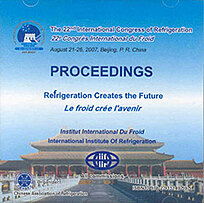
IIR document
Effects of killing, freezing and thawing condition on the change in pH, ATP concentration and amount of drip in the anchovy meat.
Author(s) : MURARA Y., ISHIDA N., KATAYAMA S., et al.
Summary
Anchovy Engraulis japonica is one of the migratory species with big catches in Japan and its stock size is stable now. Most of anchovy is frozen after capture and thawed before processing. In order to clarify effects of the killing, freezing and thawing conditions on the quality of anchovy meat, we examined the changes in pH, ATP concentration and amount of drip in frozen and thawed anchovy meat. Live anchovy were killed by two methods and then frozen: dipping into liquid nitrogen immediately (instant dispatch and quick frozen, ID) or keeping in the air for one hour and then frozen by dipping in liquid nitrogen (struggled dispatch, SD). Each specimen was stored at -30°C until experiments. Each sample was thawed by two methods of thawing: with running water (quick thawing, QT) or thawing at 0°C for 3 hours and then keeping at 5°C for 2 hours (slow thawing, ST). The ATP concentration and pH in the meat of the ID group were significantly higher than in the SD group. Most of ATP was degraded after struggled dispatch. The larger amount of drip was observed more obviously in the ID-QT group than in the SD-ST group after thawing. Most of the ATP in the meat of ID was degraded during thawing. These results suggest that thaw-rigor could be caused by residual ATP under instant dispatch in anchovy meat during thawing.
Available documents
Format PDF
Pages: ICR07-C2-1035
Available
Public price
20 €
Member price*
Free
* Best rate depending on membership category (see the detailed benefits of individual and corporate memberships).
Details
- Original title: Effects of killing, freezing and thawing condition on the change in pH, ATP concentration and amount of drip in the anchovy meat.
- Record ID : 2008-0290
- Languages: English
- Source: ICR 2007. Refrigeration Creates the Future. Proceedings of the 22nd IIR International Congress of Refrigeration.
- Publication date: 2007/08/21
Links
See other articles from the proceedings (839)
See the conference proceedings
Indexing
-
Themes:
Food engineering;
Fish and fish product - Keywords: Thawing; Anchovy; Quality; Ph; Expérimentation; Freezing
-
STUDY ON DYNAMIC PROCESS OF FREEZING AND THAWIN...
- Author(s) : LASTARRIA H. T., SWINIARSKA J.
- Date : 1983/08/07
- Languages : English
- Source: [Refrigeration serving humanity]. Proceedings of the XVIth international Congress of Refrigeration.
- Formats : PDF
View record
-
Determination and prediction of freezing point ...
- Author(s) : MATSUDA Y.
- Date : 1995/08/20
- Languages : English
- Source: For a Better Quality of Life. 19th International Congress of Refrigeration.
- Formats : PDF
View record
-
Quality of salmon (Salmo salar): effect of thaw...
- Author(s) : HAUGLAND A., JOHANSEN S., MAGNUSSEN O. M., et al.
- Date : 2000
- Languages : English
- Source: Advances in the Refrigeration Systems, Food Technologies and Cold Chain
- Formats : PDF
View record
-
Selection and application of quality indicators...
- Author(s) : NEDENSKOV K., GULDAGER H. S., JAKOBSEN G., et al.
- Date : 2001/03/28
- Languages : English
- Source: Rapid Cooling of Food.
- Formats : PDF
View record
-
Industrial thawing of block frozen fish product...
- Author(s) : HAUGLAND A., JOHANSEN S., MAGNUSSEN O. M.
- Date : 2003/08/17
- Languages : English
- Source: 21st IIR International Congress of Refrigeration: Serving the Needs of Mankind.
- Formats : PDF
View record
